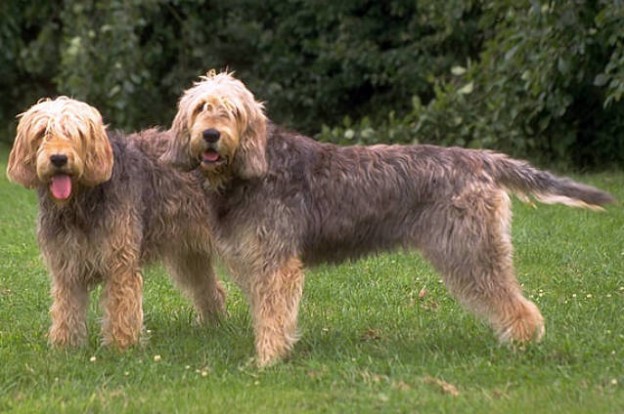
The Otterhound is a large work and hunting dog, bred for their sense of smell and stamina. Today the breed is characterised by their keen nose and shaggy coat which grows low on their face. Their infamous outer and under coat is easily managed.
Personality: Friendly with humans and all other dogs, the Otterhound is a great addition to the family. However their hunting instincts will take over when other animals are around so care should be taken when walking them. Although an intelligent breed, the Otterhound will take a lot of patience to train.
A great dog for: Active dog owners and families.
Favourite activities: Swimming, running, playing, hunting, jogging and chasing after smells.
Backyard requirements: The Otterhound is an extremely active breed and will choose to jog rather than walk alongside their human companion. They should be allowed to swim as often as possible as it is one of the exercises they are best at and has the lowest risk of injury. The Otterhound will require a large and well-fenced backyard to avoid then slipping through when chasing a scent. A good jumper, the breed will be able to jump most common fences so they will need to be strong and tall. They are able to live indoors with the family as long as they are exercised regularly.
Grooming: The Otterhound’s coat should be combed weekly but can be washed as needed. Their beard should be washed more regularly. There is minimal shedding and no trimming required.
Want more articles like this? Subscribe to Dogs Life Magazine

Commonly referred to as the Russian Wolfhound, the Borzoi has been used for hunting wolves, foxes and rabbits since the early 17th century. Shaped much like a greyhound, the breed is characterized by their long muzzle and nose. The Borzoi walks with a proud strut making this an elegant dog, associated with aristocracy.
Personality: The Borzoi is an intelligent breed of hound which is proud and very loyal to their family. The Borzoi is an old hunting breed and will never grow out of its hunting tenancies. Good around other dog breeds, the hound will need to be socialized with other non-canine animals at a young age to avoid chasing them, however they will likely continue to chase after a fleeting animal into their adult life.

A great dog for: The Borzoi is good natured but hesitant with children as they don’t enjoy rough play time. They thrive in training but require a patient owner.
Favourite activities: Training, long daily walks, hunting and running.
Backyard requirements: All hound breeds require large amounts of open space however these dogs can adapt to indoor living provided they are taken on long daily walks.

Grooming: The Borzoi sheds a moderate amount of hair and their coat needs to be groomed regularly. The fur is easy to brush with dry shampoo. The hair between the pads on their feet will also need to be trimmed frequently.
Want more articles like this? Subscribe to Dogs Life Magazine
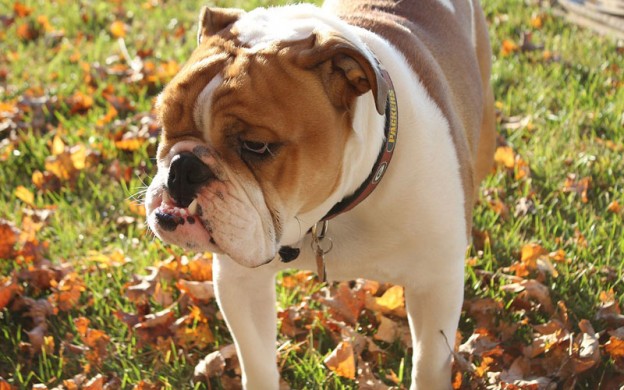
Considered a symbol of strength, the British Bulldog has earned its place as the national dog of England.
Also called the English Bulldog and British Bulldog, this breed has been around since ancient Egypt and has evolved into a good natured, family-oriented dog. One of the defining features of the breed is their rolling skin. Due to its eccentric short build and sideways motion when walking, the Bulldog is susceptible to many health issues relating to the joints, bones, respiratory system and eyes.
Personality: Originally bred for bull baiting, the British Bulldog is an amazing dog with strength and intelligence. These traits are coupled with a great temperament and an extremely laid-back personality to form a breed that has become the mascot for numerous universities, schools and organisations. Affection is one of the attributes most commonly noted about this adorable dog.
Suitability: The breed generally loves everything to do with families and wants nothing more than the affection and attention of its owners. The British Bulldog loves to be with children and also makes a great companion dog. They are well-suited to a family living in a home with a small backyard or courtyard area with plenty of shade.
Favourite activities: The British Bulldog doesn’t need a lot of exercise, but does like a walk or a romp on the beach. They enjoy being indoors and can easily overheat. A boisterous young pup, this playful breed calms down as it grows up. The Bulldog likes to be involved in whatever its owner is doing and isn’t particularly fussed about specific activities. They generally prefer to have a cuddle with a member of the family.
Watchdog qualities: Alert and inquisitive, this breed will alert the owner if anyone is around. They rarely bark, so when they do it grabs people’s attention. Their stubborn nature and strength mean they should make a good guard dog.
Hereditary diseases: Prone to overheating, the British Bulldog should never be left in a hot car. They are known to drool and snore. As with all breeds, they can inherit problems such as hip dysplasia.
Grooming: The Bulldog requires regular brushing to avoid the build up of dirt and grime in their skin folds. Wrinkles and the skin surrounding the eyes as well as the tail should be cleaned regularly to avoid moisture and infection.
Daily: Shade, fresh water and a well-balanced diet are essential. This breed is prone to overheating so it should have an area indoors where it can rest.
Weekly: Brush every week and bathe when necessary. Clean the face, wrinkles and ears.
Other: Make sure your British Bulldog is wormed, vaccinated and regularly checked for ticks.

The Wire Fox Terrier is said to have originated in the mid 19th century as a cross between the Airedale Terrier, Bull Terriers, Greyhounds and Beagles. Their distinguishing features include their narrow head and dense, wired coat. Originally bred to assist in the hunting of vermin and foxes, the Wire Fox Terrier now makes a great companion.
Personality: The lively and energetic Wire Fox Terrier is both brave and bold. They absolutely love their family and will do anything to protect them. Much like other terriers, the Wire Fox is intelligent but stubborn. Training is important from a very young age to avoid bad behaviour in the future. They like to play rough so make sure they’re treated to outdoor games and long walks. If possible, it’s a good idea to let the Wire Fox off the leash to run, however they will chase smaller dogs so be vigilant.
A great dog for: Affectionate and protective, the Wire Fox is great for families with young children with time and energy to play with the dog outdoors.
Favourite activities: Playing games, staying active, fetch, long walks, running, playing with children.
Backyard requirements: The larger the space the better for the Wire Fox Terrier. However, they can adapt to apartment living as long as they’re taken on long daily walks. A backyard is preferred.

Grooming: The Wire Fox Terrier requires a lot of grooming to look its best. Hand trimming their coat is necessary several times a year, best done by a professional. To keep the double-layered coat tangle free, the coat requires brushing a couple of times a week.
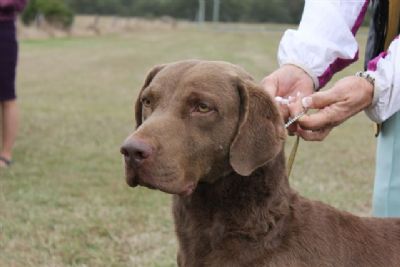
Courageous Chesapeake
Originally used for retrieving game in Chesapeake Bay on the East Coast of America, the Chesapeake Bay Retriever of today makes an affectionate and loyal companion, as Lauren Taylor discovers.
The Chesapeake Bay Retriever was developed in 1807, when an English ship crashed off the coast of Maryland. Everyone on board was saved, along with two Newfoundlands, which were given to a family of dog lovers. These dogs were later mated with local retrievers and were used for hunting in the Chesapeake Bay. Careful breeding then took place over the next few years and created an outstanding retriever with incredible enthusiasm and endurance.
This breed has a large, sturdy, athletic build and impressive muscle tone. It is believed that the Chesapeake Bay Retriever has been known to retrieve 200 ducks in a single day. Today, the Chesapeake Bay Retriever makes a fine family companion and excels in tracking, hunting, field sports and obedience.
Friendly and affectionate
The Chesapeake Bay Retriever is known to be extremely affectionate, high-spirited and loyal. They are very friendly, intelligent and loving. This breed is a marvellous companion. Just ask Trevor Lodder, who has been involved with the breed for 25 years. The Chesapeake Bay Retriever is alert, intelligent, independent, happy, devoted, protective and willing to work, says Lodder. They are best suited to an active person who enjoys outdoor activities.
A child-friendly dog
These trustworthy dogs get along wonderfully with children and other dogs, but as with all breeds, children should be supervised at all times. Once a Chesapeake Bay Retriever becomes a member of the family, the dog accepts all members of the family, whether they are human or animal. A well-socialised pup will readily accept any other pets as part of its kingdom.
This breed is a one-family dog with a very strong protective nature for what belongs to them or their adopted family; this makes them excellent watchdogs. The Chesapeake Bay Retriever is such a good guard dog that the Lodders don’t have to worry about locking the car when at the shops. They will guard the vehicle, and not let anyone near if their owner is not near, Lodder tells Dogs Life. The Chesapeake Bay Retriever does have an independent streak and will think for itself, so its best suited to a confident handler who commands authority.
The Chesapeake Bay Retriever is a cheerful breed with a bright and happy disposition. They love human companionship and thrive on human attention. They do not adapt well to solitary life in a backyard, preferring to be inside with the family.
This breed requires an average-sized backyard that is fully fenced, along with a great deal of daily vigorous activity. The Chesapeake loves the outdoors, especially water. Not enough exercise will cause the dog to become badly behaved and destructive. The Chesapeake Bay Retriever is not recommended for apartment life, as they are relatively active indoors.
Eager to please
This loving breed is very intelligent, quick to learn and always eager to please, but can easily get bored and sometimes may have a mind of its own. It is recommended to keep training sessions short, fun and consistent, without excessive repetition. They are quite sensitive, so don’t respond well to harsh training.
The Chesapeake Bay Retriever responds well to a systematic approach, and requires basic obedience training to show whos boss; they can be stubborn at times, warns Lodder.
Grooming and genetics
The dense, harsh, short-haired coat of the Chesapeake Bay Retriever is easy to groom. Weekly brushing with a firm bristle brush to remove the dead hairs is adequate. It is recommended this breed is not washed with soap or detergent, as this will remove the natural protective oil, which waterproofs the coat.
The Chesapeake Bay Retriever is generally robust and quite a healthy breed, but a very small percentage can suffer from hip and elbow dysplasia and progressive retinal atrophy, although responsible breeders test for all these conditions and breed only from stock they believe will return good results. Most breeders take time to study the bloodlines with the intent of eventually breeding these problems out of their bloodlines.
For more information, contact the Australian National Kennel Council at www.ankc.org.au
In New Zealand, please contact the New Zealand Kennel Club via www.nzkc.org.nz
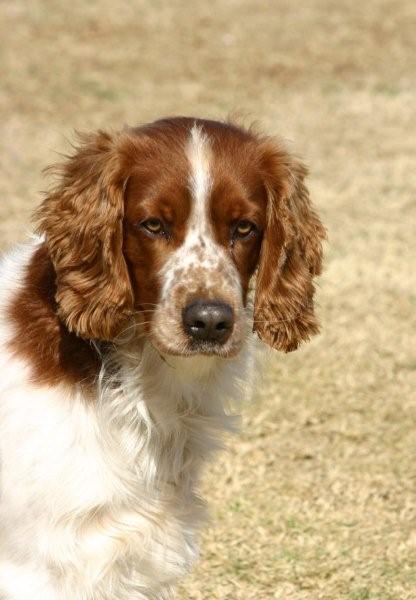
Care and exercise
The Welshie is an active dog and does best when able to get a fair amount of exercise, playing around the garden or free running in the park. Youngsters are an asset in this regard the Welshie enjoys romps and games such as chase and fetch. Otherwise, it will be content to spend a lot of its time simply in human company. Its typical spaniel coat is easy to look after, with regular brushing the main requirement and bathing only when necessary.
Suitability
The Welsh Springer Spaniel is a relatively easycare, friendly, affectionate, sensible, sturdy, small/medium dog capable of fitting in just about anywhere, provided that he is given enough exercise and allowed to be part of the family. Given plenty of human contact and affection, he will repay it over and over.
Not many people can go past a good Welshie. Not only do they make wonderful companions they are also intelligent, affectionate and easy to train!
This very attractive cousin of the better-known English Springer Spaniel differs mainly in that it stands two or three centimetres shorter, and comes only in a glorious red and white jacket, rather than the latters black and white or liver and white colour schemes. As the name suggests, this version of the hunting spaniel was developed in Wales, has existed for centuries and is still very much a favourite there today. And why not? The Welshie, as it is generally known, is a little less boisterous than the English Springer, but every bit as intelligent, affectionate, good with children and as easy to train or to look after.
A handy small/medium size, the Welshie stands about 47-48cm at the shoulder and averages around 16-20kg in weight. A robust, active sporting dog and typical spaniel, this breed responds well to training, loves a game, and is always ready for a run or walk. Bred to live with and work for its master, the Welshie is a true family dog who is always ready to please.
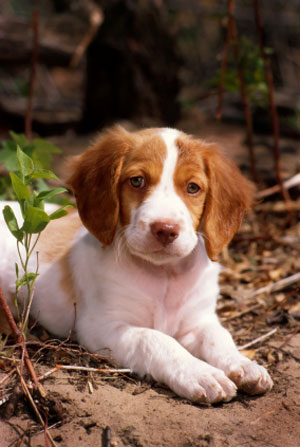
Personality: The Brittany is generally eager to please and friendly. Essentially, they are people dogs and are extremely affectionate and loyal. Bred as working gundogs, they are active and need to be kept busy. After a day out hunting or participating in other active pursuits, they like nothing better than to relax with their owners. Generally, the breed is friendly with other dogs and they also appreciate human company so will quite happily follow their owners around from room to room.
Suitable for: The Brittany primarily suits an active person who is willing to spend time with their dog and provide consistent training. The breed makes a great family pet and is very affectionate and intelligent. They’re good with children, but can knock down a small child when they romp and play, so supervision is required. Young dogs can be very excitable and therefore inclined to jump, so this behaviour should never be encouraged as it may lead to scratches on skin. They make a great pet for anyone willing to devote plenty of time to train and exercise their dog. Without this commitment from the owner the dog can quickly become bored and destructive.
Favourite activities: While mental exercise is vital for a healthy Brittany, physical exercise is extremely important. Born to spend the day in the field hunting, this dog loves nothing more than a good hunt or a run in the field and a nice, long swim. By providing your dog with daily exercise you can help prevent the demise of your backyard. The breed enjoys being in the house or garden with owners, howe’ver they can be escape artists so the yard should be secure. The Brittany can be the ideal hunting, agility, tracking, obedience and flyball partner and is always up to a challenge.
Watchdog qualities: The Brittany will sound the alarm when a stranger appears, but is not considered a guard dog because its very friendly.
Hereditary disease: Generally, the breed is quite healthy, howe’ver responsible breeders can now have their dogs hip, elbow and eye scored to reduce the chances of hereditary diseases occurring. There have been some cases of epilepsy, hip dysplasia, glaucoma and skin allergies.
Known as the Brittany or Epagneul Breton, the Brittany originated in the French province of Bretagne, which translates to Brittany.
According to Pedigree.com, in the 1850s, English sportsmen went to Bretagne with their sporting guns and well-trained Pointers and Setters and bred their dogs with the local dogs, which were later crossed with a French pointer called a Braque. This ties in with the theory that the Brittany was originally classed as a Spaniel because it was thought to have been developed as a result of a cross between the English Setter and a small Frenchland Spaniel. In 1983 the Spaniel reference was officially dropped because Spaniels mainly flush out game while Brittanys hunt, point, flush and retrieve their game.
Many believe the Brittany has been around since the early 19th century and was bred primarily as a bird hunter by peasant farmers. When the dog scents its prey, it moves in close and positions itself in a point. Then, after the hunter has shot down the birds, the dog moves in and retrieves any fallen prey. Their size and agility allow them to quickly move through dense scrub or to run across open country. What makes this breed quite unique is that the Brittany has not been split into show and field lines, ensuring a rare quality of bloodline that sees the breed still able to hunt while looking remarkably pretty and show-worthy at the same time.
Enjoying an active life
With this fascinating lineup of hunting skills, it goes without saying this is an intelligent breed that enjoys an active life. Keeping up with a Brittany requires someone with energy and the patience to train their dog from a young pup. As with all active dogs, this breed requires training to develop good manners and to learn the boundaries of acceptable behaviour.
Most owners will find their new companion a bright and willing participant, but remember that the Brittany does not respond well to shouting and threats. This is a kind-natured and sensitive breed that responds well to positive training.
Helen Green, a member of the Brittany Breed Club, explained that its a good idea to keep training sessions fun and short to maintain the interest of your dog.
The Brittanys activity level makes it an ideal choice for someone wanting a hunting, agility, tracking, flyball or obedience partner, she said.
Recent years has seen the breed competing and earning titles in most states of Australia in the field of agility. Green recalled an accomplished agility dog that had a real flair for comedy in her earlier years.
One young agility dog, with the call name Bella, had some interesting moments when she first started, Green said. She was well-known for being a social butterfly and visiting the judge, officials and spectators for a quick hello. She really took the cake one day when a netball team decided to watch the agility after their game. The girls were all a credit to their paren’ts as they sat in a long line, watching quietly well back from the ring. Seeing so many children together was too much for Bella, who decided to run over and say hello. Starting at one end of the line she worked her way along until she got to the girl with a packet of Cheezles. She stuck her head in the packet for a Cheezle and the girls all jumped up squealing, so she promptly ran back to finish her agility course.
Its nice to see an active breed with such a sweet and funny nature this is something the Brittany is certainly known for.
Daily: Each day this breed needs to receive attention. These animals thrive on interaction and require mental and physical stimulation each day. Feed them a well-balanced diet and make sure fresh water and shade is always available.
Weekly: The coat of a Brittany is low maintenance with minimal brushing required, howe’ver they generally enjoy a brush and it is a good idea to give them a brush each week. It is important to check for grass seeds and ticks every few days, particularly in tick season, and pay particularly close attention to the eyes, ears and toes.
Monthly: Foot fur may need to be groomed and the toenails regularly clipped. Ensure heartworm vaccinations and tick treatments are up to date. If the dog is to be shown, washing and brushing requirements will increase and some trimming will be required.
For more information
Australian National Kennel Council:
www.ankc.aust.com
Club LEpagneul Breton:
www.clubbreton.com.au
Contact Club Secretary Mrs Emily Lee on (03) 9772 4970 (no calls after 9pm)
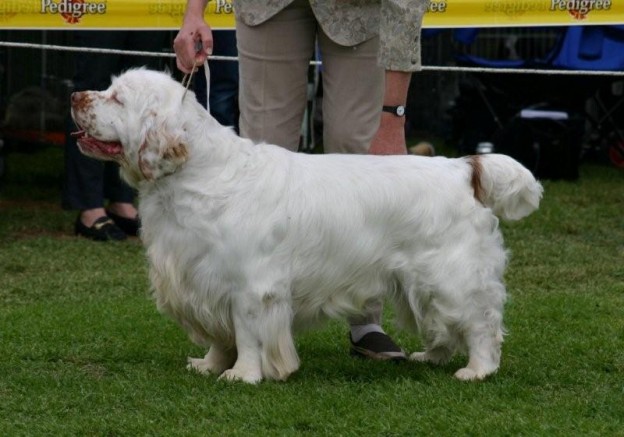
Dependable, people-orientated and friendly, the Clumber Spaniel is one of Australia’s least-known breeds. Originally bred primarily for hunting, these active dogs are intelligent and reliable.
Care and exercise
Unfortunately, the breed does have a poor reputation for hip dysplasia problems, and the eye condition entropion is another health issue to be wary of. PDP1 deficiency is a hereditary disease that is unique to Clumber and Sussex Spaniels, but has a simple recessive inheritance pattern that can be easily tested for. Before buying a Clumber, ask for a certificate for its PDP1 deficiency status or for both parents to be sure, Irving advises.
Prospective owners also need to be willing to make a commitment to their dogs health and wellbeing. Clumbers will adapt to most lifestyles, but it is still imperative for longevity and general health for the dog to be regularly brushed and given free exercise in some form, she says. A weekly brush, trimming of excess feathering every six weeks, wiping out ear canals occasionally and bathing when necessary will keep your Clumber looking great.
Suitability
Although an active breed, he is not one for rushing around the grounds and chasing balls, so this heavy, rather serious-minded dog is more suited to those who want the sensible spaniel temperament in a large frame. He is a most companionable breed and would best suit the older members of the family. With his great heart and dignity he will readily accept the youngsters but would prefer to leave the energy-using games to his smaller counterparts. Leisurely strolls are more his speed.
Friendly and adaptable
In terms of temperament and personality, Irving says Clumbers should be friendly and easygoing dogs. However, they are not outgoing dogs who will want to enthusiastically greet every single person they meet, instead preferring to get to know someone before revealing their true nature.
Clumbers love being included in all of the family activities, no matter what you may be doing. They love being with and being involved with their family exercising, walking, swimming, jogging, competing at shows or other sports and playing with the family or their toys, Irving says.
Clumbers are an elemental part of any family, although they will often have a special favourite family member. They are cautious of strangers or folk they haven’t met, but wont forget someone they like.
The Clumber Spaniel was developed on the Nottingham country estate of the Duke of Newcastle, where it was used to assist the Dukes and gamekeepers when they went hunting. The breed actually takes its name from the estate, which was called Clumber Park and is found in the north of Sherwood Forest.
These dogs were perfectly suited to working on the Nottinghamshire estates their low-set and strong build allowed them to penetrate the dense undergrowth and the white coat made them easy for the hunters to keep track of. Clumbers also possessed the necessary tenacity to stick to the trail of their game.
The Clumber first arrived on Australian shores in 1883, with the first pair coming straight from Clumber Park.
Sensible and thoughtful
Jan Irving has been involved with Clumber Spaniels her entire life. She is a third-generation Clumber fanatic and her family has owned these dogs for 50 years. I love Clumbers because they are dependable and sociable, but with a spark of fun and mischief, she says.
They are sensible, thoughtful, relatively easy to keep well groomed nobody believes you can easily keep such a white dog so clean with so little work and easy to keep fit with basic exercise.
The heaviest of the Spaniel breeds, Clumbers have a deep body with powerful legs and neck. Their thick, silky white coat helps these dogs stand out from the crowd and they also often have small markings on the face.
Some people say Clumbers moult a lot. Personally, I find they do the normal twice-yearly moult of any shedding dog, and of course they don’t have the profuse under coat of breeds like the Corgi or Malamute. Clumbers do have white hair, which does show up against just about any floor colour or furniture fabric and, like you and me, they will lose a little bit of hair throughout the year, Irving tells Dogs Life.
Irving also points out that some websites make claims about Clumbers having a drooling problem, which she denies. She says that a healthy Clumber in Australian conditions should not drool, except for that common canine reaction when confronted with a bowl of food. Drooling can be a sign of ill health or disease; it should not be and never has been a characteristic of the Clumber, Irving explains.
Finally, Irving has some sound advice for those looking to buy a Clumber Spaniel: Insist on seeing the paren’ts, speak to the breeder several times and ask if you can chat to other people who have bought dogs from their lines or their own breeding. Talk to the seller and let them know your lifestyle and basic requirements. Make the effort to learn how a healthy dog looks and behaves before taking a seller’s word on the status of the dog, she says.
She also encourages people to buy from a member of Australias only Clumber club, the Clumber Spaniel League Victoria.
www.erinrac.com/cslv
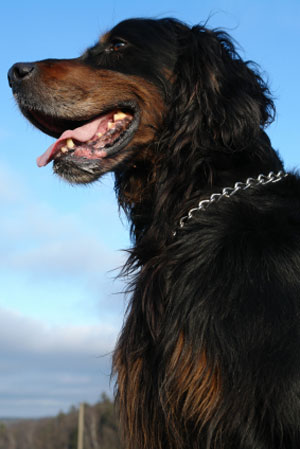
Personality: Gordon Setters are faithful and loving animals who will do anything to please their master. They can be aloof and wary of strangers until they get to know them. Gordons can be active dogs and love and excel in obedience and agility, mainly to please their master. All large dogs should have some form of basic obedience training so they can be controlled as they grow into an adult dog. Be warned Gordon’s learn from watching as well as doing.
Suitable for: The perfect person for a Gordon Setter is someone who has the time to spend with their dog and will provide the love and care it deserves. You don’t have to be particularly active as long as the dog is included in family activities and can be taken for walks. Gordon Setters love to play with balls and toys but most of all want to be with and thought of as part of the family. This is not a dog that is happy to be left in the backyard and fed each night. They are a large dog and should be supervised around children, especially toddlers, as they can knock them over unintentionally.
Favourite activities: Gordon Setters love to run and go for long walks but are also happy to play ball in the backyard or sit near you in the house. As long as they are included and doing things with you, a Gordon Setter is happy. Rigorous walks and exercise should be minimal when a puppy is growing but is essential for stimulation, weight control and general fitness of the adult dog.
Watchdog qualities: With their deep bark, a Gordon Setter will always let you know when there is something or someone unfamiliar around. Backyards need to be fully fenced with high fencing. It is advisable that the dog can’t see through the fence as they can bark at strangers moving at the front of the house because of their guarding instincts.
Hereditary disease: Gordons are pretty healthy dogs but because of hereditary diseases like hip dysplasia, all responsible breeders in Australia have been x-raying and scoring their dogs to try to eliminate the problem.
Seeing a litter of Gordon Setter pups, it is easy to understand why people simply fall in love with this breed. You can see the trademark build they will grow up to have by simply looking at their amazing frame.
Their sensitive nature makes them an ideal family pet while their laidback personality ensures they are a pleasure to have around the home. It is common for Gordon Setters to display an intense loyalty to their owners although they may take a while to become friendly with strangers.
A black and fallow dog bearing similarities to the Gordon Setter is mentioned as early as the 1600s. Around this time, Alexander, the fourth Duke of Gordon, established a kennel of Gordon Setters and this aristocratic breed was named in honour of him some time later. At this time Gordon Setters were black, black-and-white, white and tan as well as black and tan.
Alexanders kennel was at Gordon Castle near Fochabers in the United Kingdom. Although the dogs were a working breed, it is believed Alexander would not shoot over them until they were five years old as they could be boisterous and took a few years to mature.
The British Gordon Setter Club reports a story that is often denied, that Duke Alexander was responsible for the first black and tan Setter. According to the folk tale, Alexander heard of a shepherds Collie bitch that became an excellent finder of grouse at a time when his own Gordon Setters were having trouble. He confirmed these facts and decided to breed from her and, as a result, the first black and tan Gordon Setter was born. Following the death of the 5th Duke, the Gordon Castle Setters were sold, but later re-established by the Duke of Richmond and Gordon, the 6th Duke.
Daily: Feed a well-balanced diet and provide clean, fresh water and shade in their outside area. Remember, your furry friend needs lots of attention and both mental and physical activity.
Weekly: Gordon Setters have long hair, but a single coat. You should brush them at least twice a week to keep the coat free from grass and burrs and to get rid of any dead coat.
Monthly: The basic necessities of trimming nails, cleaning ears and eyes apply. Because Australia has a lot of dry grass, it is advisable to trim the feet and ears to ensure the areas remain free of grass seeds which can enter the body and cause problems.
For more information
Australian National Kennel Council www.ankc.aust.com
Gordon Setter Club of NSW www.gordonsetterclub.com
Gordon Setter Club of Victoria www.members.iinet.net.au/~gscvinc
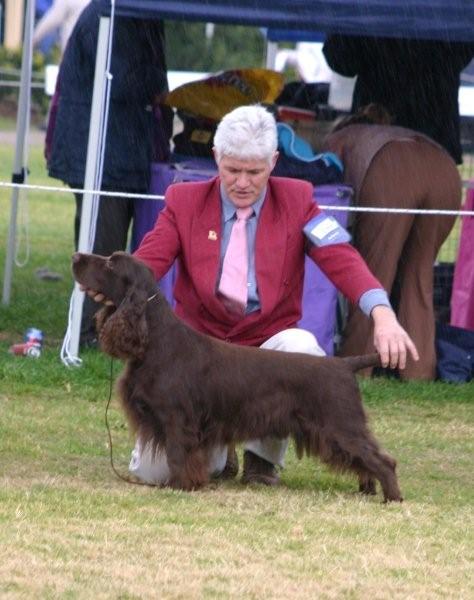
Care and exercise
The Field Spaniel is a small-medium sized dog with no exaggerations and has no special care requirements other than normal exercise, ideally including retrieving games. Coat maintenance consists of regular (preferably, but not essentially, daily) brushing, bathing as required, and trimming of feathering for neatness. Hair between the toes should be kept well trimmed.
Suitability
As a hunting spaniel, the Field is an active dog with the need for frequent exercise and is best suited for a family with plenty of yard room. Its calm, docile disposition and sturdy build make it an ideal children’s pet, but suits it just as well to an older person who can take it for regular walks.
This wonderful Spaniel is perfectly suited to family lifestyle, with their easy-going nature and friendly characters they are sure to add pure delight into any loving home.
This is one of the oldest British spaniel breeds, which for a number of reasons had almost died out by the 1940s. Hard work and dedication by a handful of breeders saw a gradual increase in numbers and, whilst ranking well behind Cockers and Springers in popularity, the Field Spaniel has just about regained its rightful place in the dog world.
Unlike its cousins, which come in solid colours or white with all sorts of patterns, the Field Spaniel should be black, brown or roan all over with only small tan markings or a white chest spot. Standing around 45cm at the shoulder and weighing 18-25kg, the Fields size fits it midway between the smaller Cocker and larger Springer Spaniels, with a relatively easy-care coat similar to theirs. Their great appeal as a family dog stems from their nature they are unusually docile, easygoing, friendly-to-a-fault dogs, active but not hyper, loving company but not needing it full time.
DogsLife is proudly powered by WordPress
